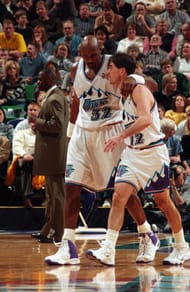
Pow-Pow: The greatest two-punch the NBA has ever seen: Karl Malone #32 and John Stockton #12. (Getty Images)
Malone’s biggest strength was his discipline and his work-ethic, lessons that he had imbibed from his difficult childhood in Summerfield, Louisiana. He was the youngest of nine kids, raised by his mother, who worked multiple shifts to provide for the family.
Now, Summerfield wasn’t a land of multiple opportunities. It was a small town inhabited by farmers and country folks, with a single school, a single store and a tightly knit community, where almost everyone knew everybody. To the silent country neighbourhood, there was a single passion that reflected in almost every single driveway in the town: their love for basketball.
However, the Malone’s weren’t rich enough to even afford the sport. They didn’t have the funds to have a card-board hung over a pole and the first basketball that Karl was gifted was actually purchased on a per-day instalment. When Karl had the ball, his mother would stand with her arms crossed in the shape of a ring and he would spend hours shooting hoops into her arms.
Explore the NBA Draft 2024 with our free NBA Mock Draft Simulator & be the GM of your favorite NBA team.
Malone, however, took naturally to the sport and quickly rose to become a high-school star, leading the school team to three Class C State Championships. It wasn’t long before Louisiana State came calling.
Malone’s exploits in Louisiana made him a prospective top draw in the 1985 NBA draft. It was even reported that he was so sure that the Dallas Mavericks would draft him eight that he had already rented an apartment in Dallas. The Mavs, however, passed on him and as destiny would have it, the Jazz landed Malone with the 13th pick. Talk about 13 being unlucky!
Malone’s rookie year was a definite eye-opener for many teams in the league as he showcased a rare mix of athleticism, stamina and the desire to run the floor that was still unexplored territory for the league’s big men.
Before Malone hit the court running, big men were stereotyped as players who needed to get the rebounds, make the easy buckets and protect the rim. Malone gave the power forward position a new dimension with his ability to run the floor and score easy points off the fast-break. Add to that his indomitable strength and basketball intelligence, and he already looked like a star in the making.
But for all his athleticism, Malone still lacked the offensive touch and the post-moves that made players like Kareem Abdul-Jabbar and Wilt Chamberlain great. It was then that Coach Frank Layden decided to tweak Malone’s style; something that would have a great impact on his career.
Layden knew that Malone wasn’t the type to shy away from hard work and he knew it was imperative that he got the required direction. Layden laid the foundations for Malone to turn from the all-energy player into the efficient low-post scorer.
Malone worked hard on his game as he improved his shooting percentage from a lowly 46% to the high-fifties. He also became a much improved free-throw shooter. The foundation was set and when John Stockton and Sloan (talking over from Layden) joined the bandwagon, the Jazz seemed destined for greatness.
Stockton and Malone made quite possibly the greatest one-two punch in the league and their famed pick-and-roll game had rival defences bamboozled. Stockton’s intelligence combined with the overwhelming repertoire that Malone had, led Utah from a struggling franchise to championship contenders in the West.
But despite putting up great regular season performances, the Jazz failed to get it done in the business end of the season, faltering to the Phoenix Suns and the Houston Rockets on numerous occasions.
Utah Jazz Fan? Check out the latest Utah Jazz depth chart, schedule, and roster updates all in one place!
